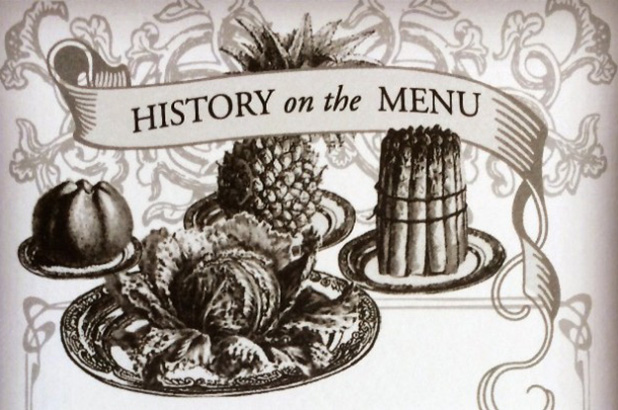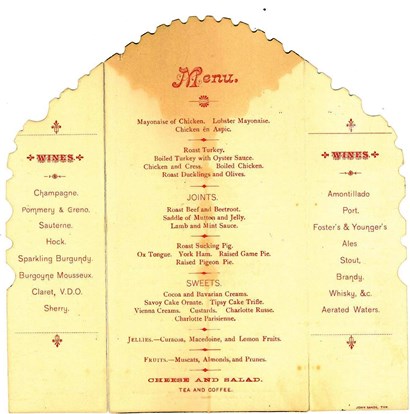How can one refuse an invitation to a wine festival? Colonial gastronomy headed west to picturesque Orange, New South Wales, to support their Villages of the heart: telling rural stories project. Renowned as central New South Wales’ food bowl, the Orange district also boasts a vibrant ‘cold climate’ boutique wine industry.
The community in Orange is raising funds to establish a regional museum (due to open in 2016) so bringing food, wine and history together with a colonial twist seemed an appropriate theme for an evening’s entertainment and wine auction. Celebrations abounded in the latter half of the 1800s, with a boom in public infrastructure and regional development between the 1860s and 1890s. Grand and gala dinners marked many of the new and progressive initiatives, including the connection of the Telegraph between England and Australia in 1872, the joining of the northern and southern railways lines in 1889, and in Orange, the opening of their town Water Supply in 1890, which was the hero menu at the Orange Wine Week event.
The food
So how do we know what food and wines were on the menu in colonial times? Fortunately for the gastronomic historian, a precious few menus from the period have survived, listing what was served at various banquets and celebratory dinners, course by course. It is then a matter of consulting period appropriate cookbooks to deduce how the dishes listed on the menus may have been cooked. The State Library of New South Wales has several menus in its collection, the earliest dated 1858. They offer a record of the food served, course by course, some include a list of wines and many, the formal toasts that were a major part of a dinner’s proceedings.
The menu cards themselves were often highly ornamented, giving an idea of artistic style in their times. Sydney’s 1888 Centenary banquet menu which we featured in a previous post is a prime example, as is this one from 1872. The bills of fare in these instances are presented in French, in which educated Australians at the time were expected to be well versed, but not all are quite so elaborate, extensive or exclusive. It is probably because of their visual appeal, or perhaps kept as mementos of a significant occasion, that these menus have survived in private and public library collections.
Of particular note on this menu is the inclusion of native species, conspicuous in their absence on the 1888 Centenary banquet menu. The Rotis or roasts – pintardes piquees – guinea fowl in a spiced wine sauce, canards aux olives – ducks with olives, wonga wonga pigeon – French for wonga wonga pigeon, and dindes sauvage – wild turkey, possibly the native brush turkey.
The wine
The majority of wines served on these occasions are imported, including French champagne, ‘Hock’ (short for Hockheimer) a German white wine seems to have been the popular, or Riesling, and the rather generically termed ‘claret’ most likely a Cabernet blend. Some of the menus feature ‘Australian’ or ‘colonial’ wines, which were gradually becoming acceptable on finer tables. The 1872 Sydney Exchange menu above is significant in that it elaborates a range of Hunter Valley wines, Kaloudah, James Doyle’s estate near Lochinvar, Cawarra, from Dr Henry Lindeman’s estate, Dalwood and Bukulla, George Wyndham’s estates. Wyndham and Lindeman’s wines are still operating today.
Order of service
This comparatively simple menu from 1878 is particularly revealing as it shows which wines were served with each course, not necessarily in the order we might expect today but typical of the times. Sherry was served with the soup course, white wine, not surprisingly, with the fish, then champagne, interestingly, half way through the dinner, with the chicken and sweetbreads. ‘Claret cup’ (a lighter or punch style red wine) served with the heavier roast and meats. Claret and Amontillado, a rich dark sherry were the ‘dessert’ wines but note that desserts were not limited to sweet dishes, they included savoury choices, in their case haddock on toast and cheese fritters.
100 years before his time
Purporting a philosophy that would take generations to adopt, Muskett urged late-Victorian Australians to recognise and respect their locale and its climate,
[I]t is only in keeping with the rest of our food habits, with their perpetual challenge to our semi-tropical environment… [that] we are confronted with the astounding fact that although we are practically Southern Europe… we follow a mode of living suitable only for a rigorous climate and a land of ice and snow.

Nineteenth-century inspired menu for ‘History on the menu’ Orange Wine week event, 2014. © Orange City Council
Getting tongues wagging
The formal menus inspired the tastings selection for the fundraiser, put together by talented Orange foodie, Cath Thompson and a crew of energetic helpers, and local winemaker Stephen Doyle generously donated his time and wines to support the event. Highlights of the menu were truffled vol-au-vents, Cath’s chicken in a French herbed butter sauce and the venison pies. Having tongue on the menu is often challenging for some people, but Orange is home to highly food savvy folk who display open minds and adventurous tastes, and I was delighted to see the platters returning to the kitchen empty! And what were oysters doing in an inland country town? Oyster bars operated in Orange soon after the NSW railway system came through in 1877, bringing rapid change to commerce, culture, and cuisine.
Villages of the heart: telling rural stories
Villages of the Heart is a project that focuses on villages, past and present, in the Orange, Cabonne and Blayney region. Funding has been made available from Arts NSW, Orange, Cabonne and Blayney Councils. The project is aims to capture treasured stories through oral history and shared knowledge – linking the past and present – people, events and stories with the villages. Key themes include: village secrets, from pasture to plate, places, gold and lost villages. To see more Villages of the heart: telling rural stories go to Central NSW museums.
Chicken with French-herb butter sauce
Ingredients
- 125g unsalted butter
- 1 tablespoon herbs de Provence, or French style 'fine herbs'
- 500g chicken breast or tenderloin fillets, trimmed
- 1 tablespoon butter or olive oil, for sauteing
Note
This very simple 19th-century-inspired dish was served at a Wine Week event in Orange, New South Wales, courtesy of local foodie and caterer, Cath Thompson. The typical English-style melted butter sauce is infused with herbs de Provence, a French mixed herbs blend, as a nod to the trend of presenting formal banquet menus in French, assuming any guest of merit would have had appropriate tutelage.
Directions
| Cut butter into several pieces and place in a heatproof jug. Stand the jug in a pot of boiling water, stirring gently until the butter melts. Do not ‘cook’ the butter or solids will separate. Add herbs and set aside for an hour or two, to allow flavours to infuse, then refrigerate until required. | |
| Slice chicken into manageable pieces, approximately 2cm x 5cm. Pan-fry the chicken pieces in fresh butter or olive oil until golden. Add 1/3 cup water, cover and steam for few minutes to ensure it is cooked through. Meanwhile, re-warm the butter sauce by standing in a pot of boiling water until melted. Once cooked, transfer chicken to a serving plate, spooning the herbed butter over the pieces, and serve immediately. | |
| COOK’S TIP: If serving as finger food, thread the chicken pieces onto skewers and serve with butter sauce in a shallow dipping dish. | |






 Print recipe
Print recipe

